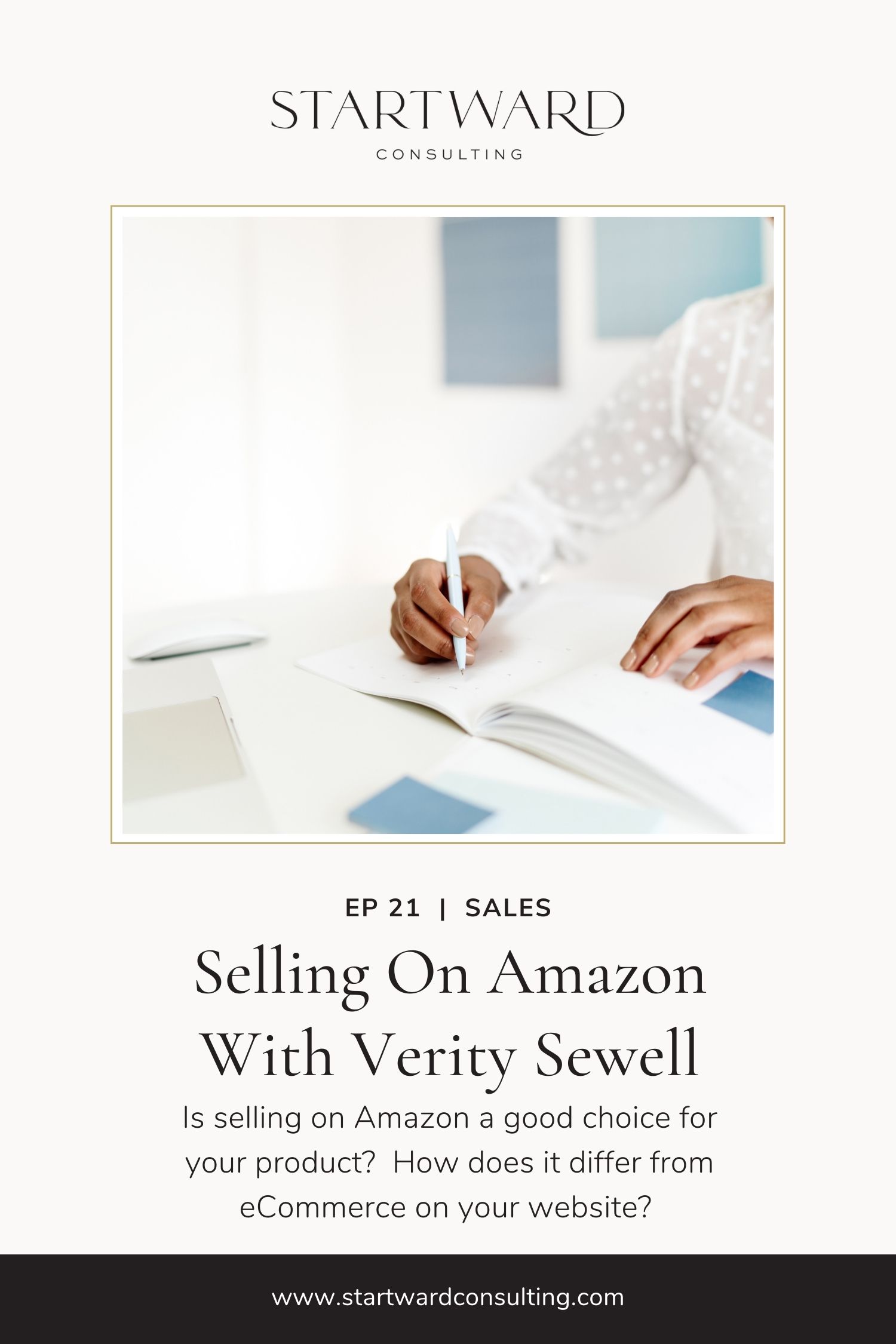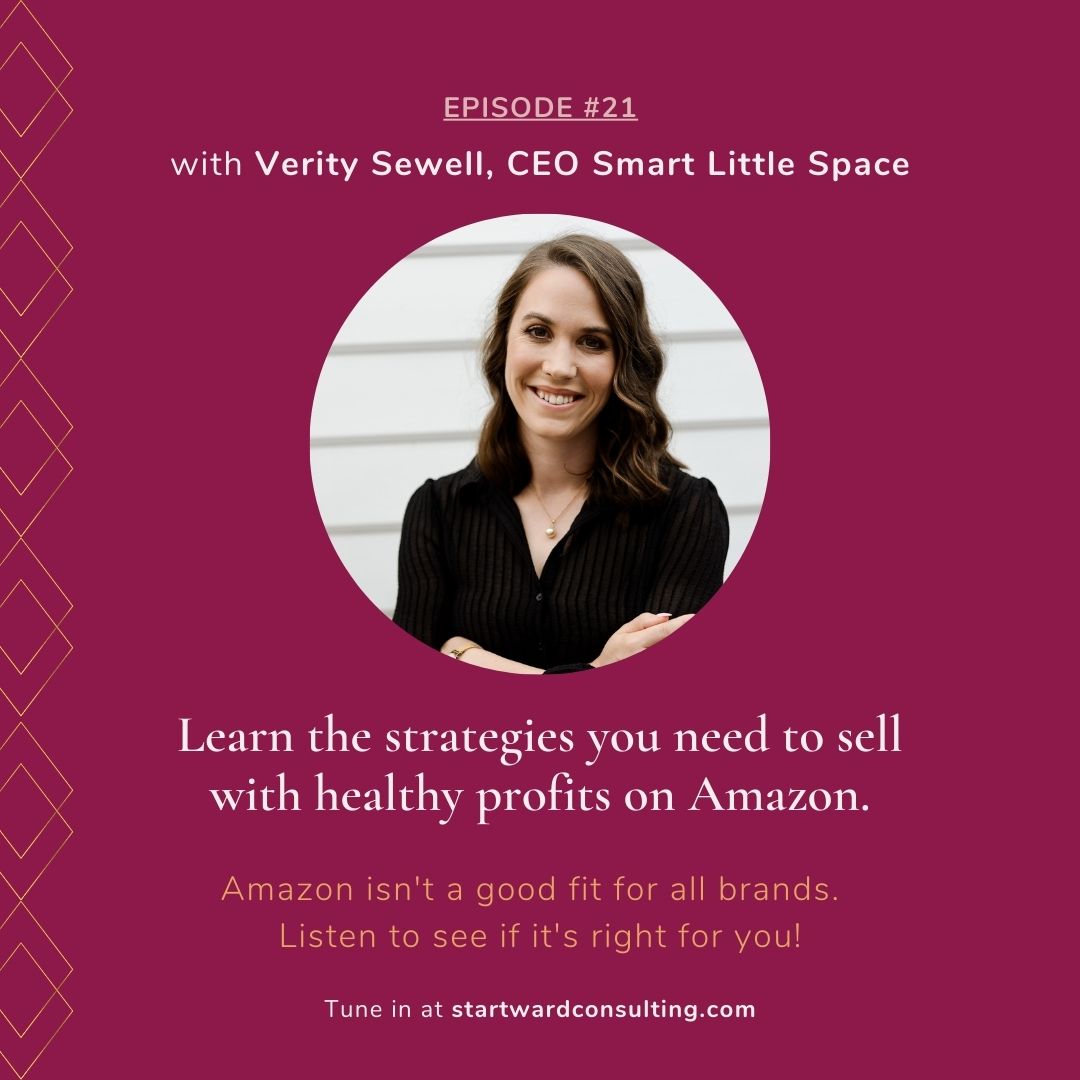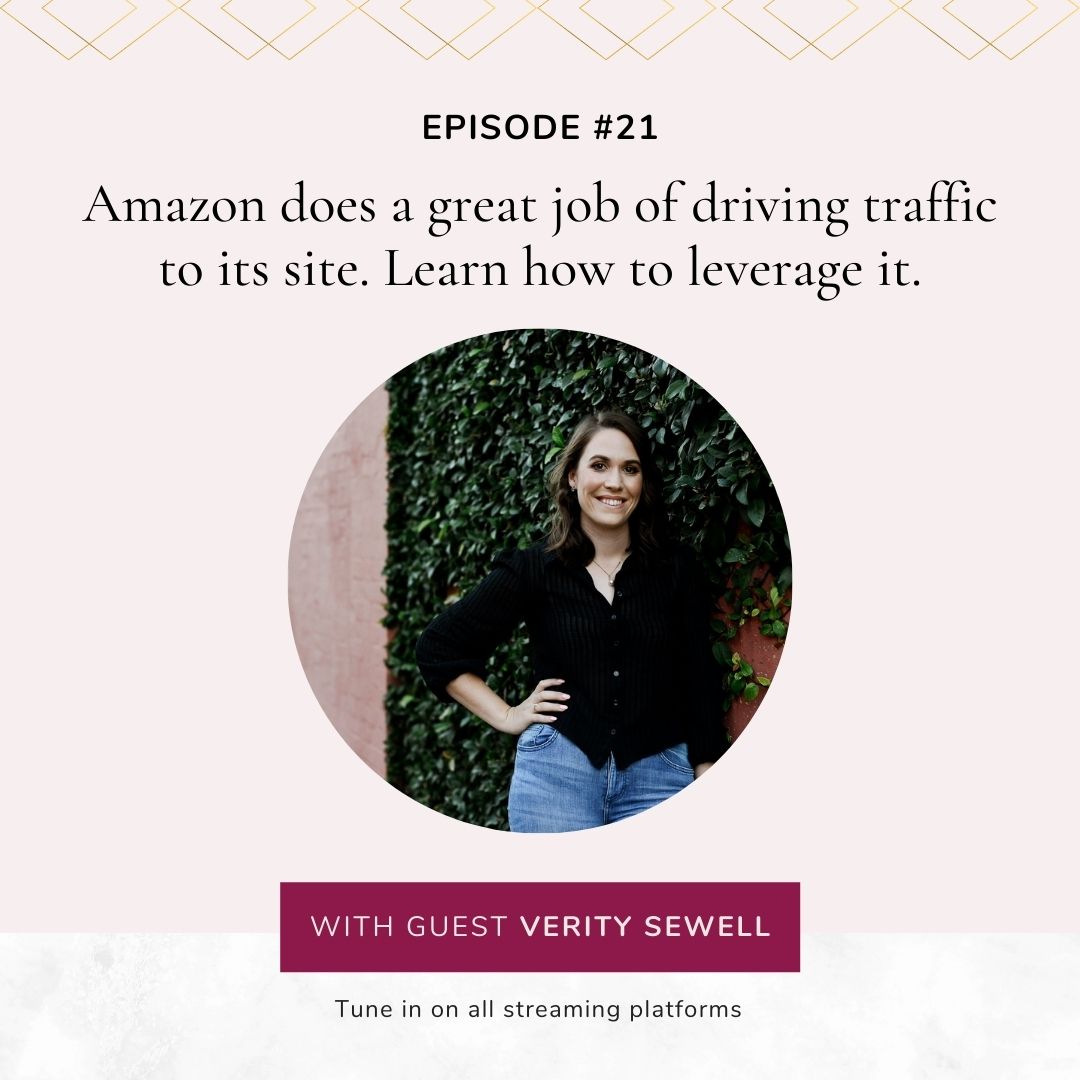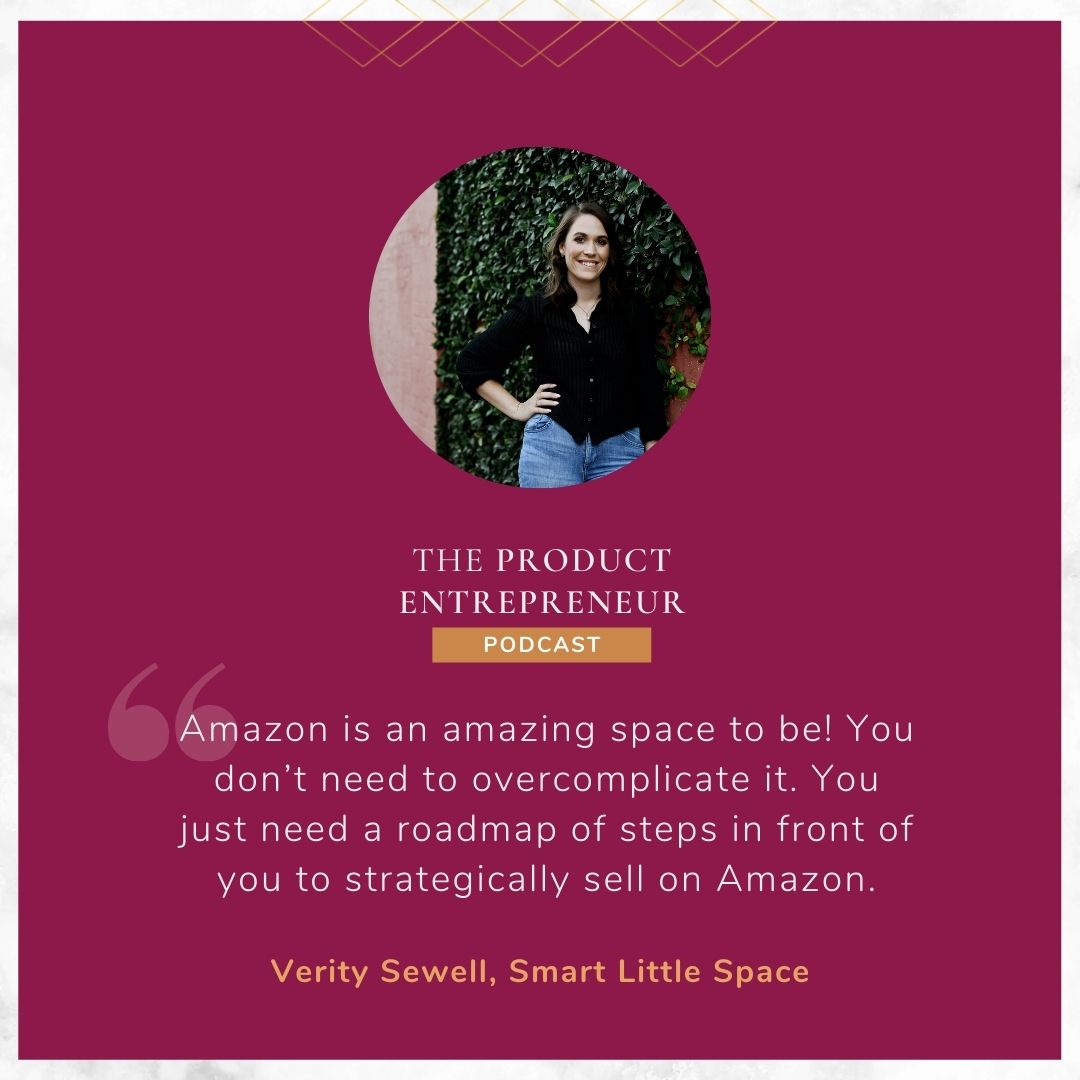Episode 21: Selling On Amazon With Verity Sewell

Verity Sewell, founder of Smart Little Space, shares how to navigate selling on Amazon. She helps product owners set up and launch their brands on Amazon, and has worked with 100s of entrepreneurs to skyrocket their sales.
Is Amazon a good platform for you? How does it differ from eCommerce on your website? Verity and Maureen discuss this and more!

A little about Verity....
In 2012, Verity was a private label seller. She created products specifically for Amazon. She began selling in USA, UK, and Europe. As she grew her brand, she then was approached by an Amazon agency to work with product based brands.
Following success in this agency, she went on to launch Smart Little Space to help female entrepreneurs sell on Amazon. She wanted to help people feature how amazing their products are and leverage the traffic already on Amazon. She now helps entrepreneurs sell globally through Amazon.
Ultimately, she has seen Amazon sales help people ramp up their businesses. Because people aren’t talking about female-focused brands in the space, she has honed in on supporting female entrepreneurs through Smart Little Space.
How To Overcome Amazon's Competitive Marketplace
Amazon is known for a competitive marketplace and thin profit margins. This causes selling on Amazon to feel overwhelming to a new seller. However, it doesn’t have to be this way. There is a very strategic way to map out selling so that it isn’t overwhelming.
While people often talk about revenue on Amazon, they do not talk about profitability. It's important to remember that profit trumps revenue. Many times, people will sell successfully on Amazon, but not make much money. Because of this, you have to ensure that the platform fits for you. It doesn’t fit everyone’s product brand, but there are ways to work out profitability so that it works for you.

How To Make A Profit On Amazon
First, make sure that you are selling in a price range that gives you enough profit. The sweet spot is usually selling at a price between $20 & $50. This is because people will buy items without thinking too much about it. Anything lower likely won’t offset selling fees.
Verity teaches Fulfilled By Amazon (FBA). This allows you to qualify for Prime. However, there are fees included with Amazon fulfillment. She recommends going onto Amazon's site to use their revenue calculator. This calculator allows you to put in your product details and look at the cost to sell. You’ll input selling price, product dimensions, and other product-specific information. Then, Amazon will show you the fees associated with selling. If you feel that the costs are too high, you can often cut costs through packaging.
Packaging Products For Amazon
Many product owners have beautiful packaging. However, on Amazon, oversized packaging is costly. Some brands change their packaging just for Amazon to avoid additional costs. If you are packaging products specifically for Amazon fulfillment, you want your packaging to be as tight around the product as possible. You should also seek to make it as light as possible.
On Amazon, people are usually looking for a 30% return on their investment. This is a good average to start with in order to help profitability. Verity recommends working with the numbers and packaging costs until you reach around an estimated 30% ROI.

Consider Competitors On Amazon
When you are looking at competition, go on Amazon and see what’s happening. This is more effective than searching google, because you may have competitors who sell solely on Amazon.
Once you find these competitors in your product category, scope them out. You can do this by searching on Amazon for products similar to yours. Type in something you would look for. Then see if there is a gap in the market for your product.
Then, scroll through multiple pages to see how pricing compares on Amazon for this product category. Could you go down or come up on your cost? It is good to be in the middle, rather than the least or most expensive.
Next, click into the listings and see what your competitors are doing. Even if their product is similar in offerings and price, the listing itself could provide a space for you on Amazon. Ask a few questions as you look. How is the image quality? Do they have graphic designs to describe the product? Are they using bullet points on their details? How is the seller’s storefront? If you can do a better job in these areas, this is a gap you can fill.
By researching competitors and gaps in your product category, you will be able to sit in the sweet spot of pricing and product listing. This empowers you to take advantage of a gap in the market.
What Types Of Products Perform Best On Amazon?
While positioning is most important for success on Amazon, there are some categories that are more difficult to get into. These are known as gated categories. They have highly specific regulations that your products must match.
Believe it or not, gated categories can create an opportunity for you. Many sellers don't want to deal with the regulations, so there is less competition. You simply need to be prepared to go through a few extra steps to be approved for selling in that category.
You can also google Amazon bestsellers to see all the categories and sub categories. If you sell in a sub category, it will allow you to niche down. However, you need to be in a category that can be found through search words rather than being a best seller.
How Can You Gain Visibility While Selling Beauty Products On Amazon?
You can gain visibility for your beauty product just like you would for any other product category on Amazon. The good news is that Amazon is already doing a great job of driving traffic to its site. Amazon often makes buyers feel safe because of their name recognition and return policy. It also provides the convenience of a supermarket that offers many different products. This makes Amazon a great market to leverage for selling your product. However, your listing needs to be optimized.
Use keywords and great quality images. Keywords allow people to search for a product like yours and find your brand.
While your keywords get you found, and your images get you sold. You want the images to be compelling to buyers. This can help you stand out from similar listings.
Amazon also gives you options for visibility within their ecosystem. When you become a seller and have a seller account, you will have certain tools to leverage. You can advertise, offer coupons, and do promotions.
This means that, while you don’t have to drive traffic to Amazon, you can hook people already on the platform. One way to do this is to run Amazon ads. These are simple to run, but there are also people you can outsource to run your ads.
Similar to Facebook and Google, you can do manual or automatic campaigns with your keywords to get you found. You can also run headline ads that feature three products and a logo. Video ads have recently been added as an option on Amazon.
Coupons on Amazon are another good way to drive traffic. While coupons are big in America, they are not as big in the UK. If you run a promotion, this would look like offering multibuys, cross promotions, or social media promotions with links.
If you are already selling elsewhere, you can lead people to your Amazon listings as well.
What Market Should I Prioritize Selling In Through Amazon?
Don’t overcomplicate this. Being able to sell globally through Amazon is a big deal, but keeping it simple means starting in the biggest marketplace. Because USA is the biggest marketplace, and it will allow you to test. You will find out if Amazon is the right product for you by selling here. The only time this is not helpful is if you never plan to sell in the USA.
Before you get ahead of yourself and plan to open multiple seller accounts, start with just Amazon US and really understand the platform. It has different requirements than other platforms, so working in multiple countries can get confusing.
As you grow, you also need to be able to grow with your platform. Knowing your platform's regulations is important. You’ll have to plan to leverage your business and be able to provide greater quantities of products. Focusing on one market also allows you to avoid dealing with currencies in different countries.
You do not have to live in the US to sell there. You can sell on the Amazon US platform from other countries. As you do so, you’ll be able to leverage FBA, send your stock over to Amazon, and sell anywhere in the world.
If you are considering selling in Australia or Singapore, you have to be strategic. These are baby platforms that are still fairly new. Because they are small, don’t start there. They will not give you enough data as you test your product. You also won’t see a lot of revenue or success in selling on a small platform. Start with the US platform and then leverage your success when you move into smaller platforms.

What To Consider When Weighing eCommerce Against Amazon
Verity recommends using both platforms to best support sales online. She didn't think sellers should have all their eggs in one basket. If you’re not on Amazon, you should consider it. If you are on Amazon, think about where else you should be selling.
We know that Amazon shoppers are getting really smart. They like to check out the brands they find on Amazon. Often, they’ll visit the seller’s website or social media to check them out, and then go back to Amazon and buy off that platform. This is a trust issue, so they prefer to trust Amazon for fulfillment. But, if you don’t have a website for the buyer to look at, their trust in your product will drop.
After looking at all the pieces of the puzzle around profit, does Amazon make sense? If you sell on just one channel, you risk losing sales if your website drops or if Amazon fails. It is good to plan things out for your business and ensure you don't rely too heavily on one channel.
You can map out on a spreadsheet what your plans are for each of the channels working together. You can lead people to Amazon from your other channels, and you can lead people to your other channels from Amazon. Having an omni channel approach is great and will help you as an Amazon seller.
If you want to keep it simple, just add one channel at a time. Amazon might be a lucrative first way for you to reach customers.
How To Choose Products For Selling On Amazon
Verity and Maureen agreed: Don’t try to launch more than three products at once. It’s overwhelming and requires a lot of work for each product. This also helps you avoid putting too much risk into a single product. Verity avoids risk on Amazon. Selling just three products allows you to leverage the platform without becoming overwhelmed financially.
Here is how to choose those three products:
- Consider your product range. For example, if you have 20 products, look for your best seller. Rank all your products based on sales. Then, think about what makes them the best sellers. Would they work on Amazon?
- Then, look at your pricing. Does it tick the box in terms of fitting what other people are selling for? It doesn’t need to be the lowest or highest, but it does need to fit the range.
- Next, look at the free revenue calculators on Amazon and see if the profit looks right for that product. If there isn’t enough profit, then wait on the product. You’ll need to find ways to cut costs before selling on Amazon.
If there is enough profit, can you scale production of the item? You need to be able to create volume for your product so that you are not constantly in and out of stock.
Do this for each of your products until you’ve shortened your product list down to three.
Then, once you’ve found your three, ask yourself if those products compliment each other. While the product works well on its own, you’d also like to see these products working well together. This means that you could promote a second product when people are ready to purchase your first one.
Selling On Amazon Sounds Good, But I Don't Know How To Start
Whether you are just getting started in business, or you are already established, you have already overcome the hardest part. That challenge is developing the mindset required to overcome the hurdles of validation, manufacturing, etc.
Now you’re looking at how to grow. Product owners are often ready to start thinking about scaling, but they aren't sure where to start. Amazon is an amazing space to be! You don’t need to overcomplicate selling on Amazon. You just need a roadmap of steps in front of you to strategically sell.
Find out more!
- Subscribe and rate our podcast on iTunes here.
- Android users can subscribe and rate our podcast on Spotify.
- Join our incredible community - Product Entrepreneurs Who Scale
- Learn how Maureen can help you grow your brand in any stage.
- Follow Verity Sewell's brand on Instagram
- Visit Smart Little Space online.
- Join Verity's Facebook Group




